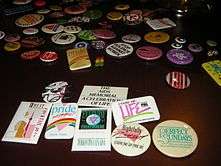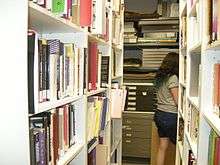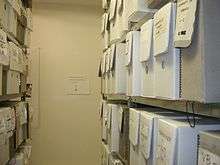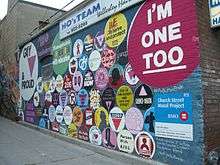Canadian Lesbian and Gay Archives
| Abbreviation | CLGA |
|---|---|
| Formation | 1973 |
| Type | Archive organization based in Toronto, Ontario, Canada |
| Legal status | active |
| Purpose | advocate and public voice, educator and network |
| Headquarters | Toronto, Ontario, Canada |
Region served | Toronto, Ontario, Canada |
Official language | English, French |
| Website | Canadian Lesbian and Gay Archives |
The Canadian Lesbian and Gay Archives is the largest independent LGBTQ+ Archives in the world, acquiring, preserving and providing public access to material on the history of lesbian, gay, bisexual, transgender and queer communities in Canada. The CLGA is a non-profit organization in Toronto, Ontario, Canada.
The Archives were established in 1973 by The Body Politic's editorial collective (also known as the Pink Triangle Press). Originally named the Canadian Gay Liberation Movement Archives, the organization became the Canadian Gay Archives in 1975; established a separate collective in 1976; incorporated in 1980; received Charitable status in 1981; formed a board of directors in 1992; and adopted its current name in 1993.[1] Beginning as a one-cupboard reference collection co-housed with Pink Triangle Press, the Archives relocated to an independent location on Temperance Street in downtown Toronto in 1992. In November 2005, the CLGA moved to a temporary location at 65 Wellesley Street in the city's Church and Wellesley gay village; launched a fundraising campaign; and began the search for a permanent home in the same area. The historic Jared Sessions house at 34 Isabella Street (built in 1860[2]), was donated to the Archives by the city's Children's Aid Society after CAS began construction on a newer, larger building next door. After major renovations to 34 Isabella Street, the Canadian Lesbian and Gay Archives re-opened in September, 2009. Today the Archives host a reading room and rare book library, vertical file room, offices, AV room, and gallery space for exhibitions. Additional holdings remain at 65 Wellesley and in deep storage[3]
Collections
The Canadian Lesbian and Gay Archives was established in order to “preserve, organize, and give public access to information and materials in any medium, by and about LGBT people, primarily produced in or concerning Canada.”[4] As such, the archives are not limited to traditional printed material, but instead contain many diverse collections.
Artifacts
In addition to traditional printed material (over 3000 books, diaries, booklets, leaflets, programmes, zines, press clippings, etc.), the Archives collects artifacts that would normally be considered museum objects to capture specific moments in the history of the lesbian and gay community.[5] Such artifacts include:

- Banners and flags
- Buttons and pins
- Leather items
- Matchbooks and matchboxes
- T-shirts
- Trophies
- Uniforms
Artwork
The Archives have acquired over 500 original works of art from within the lesbian and gay community. These are primarily paper or canvas works, and the emphasis is historical.[6] Examples include:
- Costumes, drawings and photographs by Ronald McRae
 CLGA Library
CLGA Library - Paintings by JAC, the artist collective of John Grube, Alex Liros and Clarence Barnes
- Works exhibited by Gallery Without Walls
- Submissions for Toronto’s AIDS Memorial
Audio Recordings
Containing more than 2000 hours of sound on tapes and over 1300 discs, the Archives house LPs, gramophone records, cassettes, and CDs. Much of this material is vocal or instrumental recordings of lesbian and gay performers, but there is also a significant library of taped interviews and radio programs, as well.[7]
Moving Images
The moving images collection includes more than 2200 items, in 8 mm film and 16 mm film, Betamax, VHS, and DVD formats. While there are feature films, documentaries, and erotica housed in the Archives, there are also videos shot at lesbian and gay community events.[8] Because of its extensive collection, the Archives are often used to provide source material for Canadian film projects, such as Forbidden Love.[9]
National Portrait Collection
Established in 1998, the National Portrait Collection honours individuals who have contributed to the growth and development of the LGBT community in Canada. Currently, the collection holds 75 portraits in various mediums, including photography, watercolour, and oil.[10]
As of 2016, people depicted in the portrait collection include Elmer Bagares, Chris Bearchall, Rick Bébout, Anne Bishop, Persimmon Blackbridge, Nicole Brossard, Alec Butler, Bernard Courte, Harold Desmarais, C.M. Donald, Michelle Douglas, John Duggan, Sara Ellen Dunlop, Jim Egan, Gloria Eshkibok, Lynne Fernie, John Fisher, Janine Fuller, Richard Fung, Amy Gottlieb, John Greyson, Brent Hawkes, Gens Hellquist, Tomson Highway, Charlie Hill, George Hislop, Richard Hudler, David Kelley, Robert Laliberté, k.d. lang, Denis Leblanc, John Alan Lee, Bev Lepischak, Alan Li, Michael Lynch, Ann-Marie MacDonald, Jovette Marchessault, Tim McCaskill, Mary Meigs, Billy Merasty, Robin Metcalfe, Peter Millard, Bonte Minnema, Jearld Moldenhauer, Shani Mootoo, Alex Munter, Pat Murphy, Glen Murray, Nancy Nicol, Richard North, Keith Norton, Carmen Paquette, Carole Pope, Ken Popert, Kyle Rae, Rupert Raj, Neil Richards, Marie Robertson, Svend Robinson, Gerry Rogers, Jane Rule, Craig Russell, Kyle Scanlon, Shyam Selvadurai, Makeda Silvera, Mary-Woo Sims, Tim Stevenson, Douglas Stewart, Barbara Thornborrow, Shelley Tremain, Susan Ursel, Chris Vogel, Delwin Vriend, Tom Warner and Douglas Wilson.
Periodicals
The Archives contains the largest collection of lesbian and gay periodicals in the world, with over 9500 individual titles.[11] The Archives also house a general collection of periodicals not specifically produced for the lesbian and gay community, but concerning feminism, the arts, and alternative culture that include lesbian and gay issues and an indication of changing attitudes in mainstream media.[12]
Personal and Organizational Records

The Archives holds the records of Canadian lesbian and gay organizations, as well as the personal records of prominent Canadians active in, or significant to, the lesbian and gay community.[13] This includes
Photographs
Beginning as the photo files for The Body Politic, the Archives grew around the photograph collection, and while many of the items are not yet cataloged due to the high number of entries, the Archives currently houses over 7000 individual items in various mediums, including prints, negatives, and halftone reproductions.
In terms of scope, the photographs depict the community in a broad sense; photographs of demonstrations, conferences, social events, performances, and police harassment, as well the personal, domestic and social lives of lesbians and gay men.[14]
Posters
Posters in the Archives are predominantly Canadian, with some international, representing film, theatre, concerts, parties, bars, and avant-garde art, within the lesbian and gay community.[15]

Vertical Files
The Archives currently hold over 30,000 vertical files on people, groups, and events affecting the lesbian and gay community. Unlike most of the Archives, the vertical files provide information about an individual or organization, rather than information produced by the individual or organization. The vertical files contain approximately fifty percent Canadian content and fifty percent international content.[16]
Exhibitions
With an additional mandate to exhibit work that honours LGBTQ+ community and encourages dialogue, the Archives has a vibrant exhibition programme. A sample of past exhibitions includes:
- We Could Be Heroes (Just For One Day) (March to May 2016)
- Queering Space (June to September 2015)
- Marked: Tattoos & Queer Identity (April to May 2015)

- Butch: Not Like the Other Girls (November 2014 to January 2015)
- Rocking the Boat: Celebrating Queer Content in Canadian Concert Dance (November 2013 to April 2014)
- Colour Coded: queer abstraction meets fruity frosting (September to November 2013)
- Gay Premises: Radical Voices in the Archives, 1973-1983 and TAG TEAM: Gay Premises (June to September 2013)
- Public Sins / Private Desires: Tracing Lesbian Lives in the Archives, 1950 - 1980 (June to August 2012)
- CENSORED LIVES: Suppression, resistance and free speech (June to September 2010)
- National Portrait Collection (September 2009 to November 2010)
Outreach
CLGA's outreach initiatives include tours and study opportunities for undergraduates.[17]
See also
References
- ↑ Sheffield, R. (2015). The Emergence, Development and Survival of Four Lesbian and Gay Archives (Unpublished Doctoral Dissertation). University of Toronto, Toronto
- ↑ "TOBuilt: Toronto's Oldest Buildings". www.tobuilt.ca. Retrieved 2016-10-03.
- ↑ "34 Isabella Street Grand Opening". Canadian Lesbian and Gay Archives. 2009-09-15. Retrieved 2010-06-29.
- ↑ "About Us". Canadian Lesbian and Gay Archives. 2010. Retrieved 2011-10-23.
- ↑ "Artifacts". Canadian Lesbian and Gay Archives. 2010. Retrieved 2011-10-23.
- ↑ "Artwork". Canadian Lesbian and Gay Archives. 2010. Retrieved 2011-10-23.
- ↑ "Audio". Canadian Lesbian and Gay Archives. 2010. Retrieved 2011-10-23.
- ↑ "Moving Images". Canadian Lesbian and Gay Archives. 2010. Retrieved 2011-10-23.
- ↑ "Film Makers and the CGA". Canadian Lesbian and Gay Archives. November 1992. Retrieved 2011-10-23.
- ↑ "National Portrait Collection". Canadian Lesbian and Gay Archives. 2010. Retrieved 2011-10-23.
- ↑ "Periodicals". Canadian Lesbian and Gay Archives. 2010. Retrieved 2011-10-23.
- ↑ "General Periodicals". Canadian Lesbian and Gay Archives. 2010. Retrieved 2011-10-23.
- ↑ "Collections". Canadian Lesbian and Gay Archives. 2010. Retrieved 2011-10-23.
- ↑ "Photographs". Canadian Lesbian and Gay Archives. 2010. Retrieved 2011-10-23.
- ↑ "Posters". Canadian Lesbian and Gay Archives. 2010. Retrieved 2011-10-23.
- ↑ "Vertical files". Canadian Lesbian and Gay Archives. 2010. Retrieved 2011-10-23.
- ↑ Zieman, K. (2009). Youth outreach initiatives at the Canadian Lesbian and Gay Archives. Archivaria, 68, 311-317.
External links
Coordinates: 43°40′05″N 79°23′20.3″W / 43.66806°N 79.388972°W